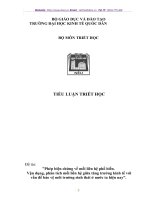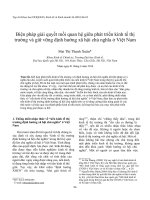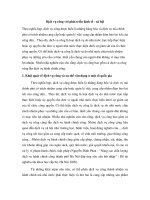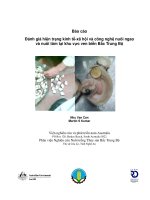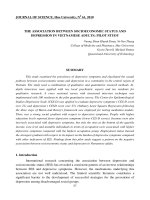Báo cáo nghiên cứu khoa học: "Mối liên hệ giữa tình trạng kinh tế xã hội và trầm cảm ở người việt Nam: thí điểm nghiên cứu" pps
Bạn đang xem bản rút gọn của tài liệu. Xem và tải ngay bản đầy đủ của tài liệu tại đây (121.5 KB, 22 trang )
57
JOURNAL OF SCIENCE, Hue University, N
0
61, 2010
THE ASSOCIATION BETWEEN SOCIOECONOMIC STATUS AND
DEPRESSION IN VIETNAMESE ADULTS: PILOT STUDY
Vuong Diem Khanh Doan, Vo Van Thang
College of Medicine and Pharmacy, Hue University
Gavin Turrell, Michael Dunne
Queensland University of Technology
SUMMARY
This study examined the prevalence of depressive symptoms and elucidated the causal
pathway between socioeconomic status and depression in a community in the central region of
Vietnam. The study used a combination of qualitative and quantitative research methods. In-
depth interviews were applied with two local psychiatric experts and ten residents for
qualitative research. A cross sectional survey with structured interview technique was
implemented with 100 residents in the pilot quantitative survey. The Center for Epidemiological
Studies-Depression Scale (CES-D) was applied to evaluate depressive symptoms ( CES-D score
over 21) and depression ( CESD score over 25). Ordinary Least Squares Regression following
the three steps of Baron and Kenny’s framework was employed for testing mediation models.
There was a strong social gradient with respect to depressive symptoms. People with higher
education levels reported fewer depressive symptoms (lower CES-D scores). Incomes were also
inversely associated with depressive symptoms, but only the ones at the bottom of the quartile
income. Low level and unstable individuals in terms of occupation were associated with higher
depressive symptoms compared with the highest occupation group. Employment status showed
the strongest gradient with respect to its impact on the burden of depressive symptoms compared
with other indicators of SES. Findings from this pilot study suggest a pattern on the negative
association between socioeconomic status and depression in Vietnamese adults.
1. Introduction
International research concerning the association between depression and
socioeconomic status (SES) has revealed a consistent pattern of an inverse relationships
between SES and depressive symptoms. However, the mechanisms underlying this
association are not well understood. The limited scientific literature constitutes a
significant barrier to the development of successful strategies for the prevention of
depression among disadvantaged social groups.
58
Most of the research examining the association between SES and depression has
emanated from developed countries. There are very few studies of this association from
low- income nations, where different socio-cultural systems may contribute to
differences in the major aetiologies of common mental disorders. In Vietnam, there is a
serious dearth of research on depression and no investigation of the association between
SES and depression. As a consequence, it is impossible to obtain an accurate picture of
the extent of the SES- depression gradient and the nature of this association in the
country.
The main purpose of this study is to document the prevalence of depression in a
community in the central region of Vietnam and to elucidate the causal pathways
between SES and depression. The study uses a combination of qualitative (interviews)
and quantitative methods (survey). The qualitative research is used to inform a
theoretical model of the social determinants of depression and also to develop culturally
appropriate instruments for the quantitative survey. The survey will estimate the
prevalence of depression in Vietnamese adults and examine the nature and extent of the
association between SES and depression in this population. The study will contribute
new evidence regarding the burden of mental distress in Vietnam. The findings will
have practical relevance for advocacy for mental health promotion and health care
services. More broadly, the work will contribute to international scientific literature on
the social determinants of depression.
This article presents the main findings of the pilot study, which include two
parts: the exploratory qualitative research and the pilot quantitative research.
2. Methodology
2.1. Setting
The study was carried out in Hue city, the capital of Thua Thien Hue province.
The city is located in central Vietnam on the banks of the Perfume River, and lies 20 km
inland from the Pacific Ocean. Hue city is about 540 kms south of the national capital of
Hanoi and it has a total population of more than 350,000 inhabitants. The city is divided
into 27 administrative units called quarters.
One quarter of the city was selected randomly for conducting the pilot study
between November and December 2008. This quarter- Phu hoi-lies in the centre area of
the city, has a total population of 10,121 and is divided into 16 subdivided
administrative units.
2.2. Data collection
Exploratory qualitative research: The principle investigator conducted in-depth
interviews with 2 local psychiatric experts and with ten randomly selected residents of
Phu hoi quarter in Hue city.
59
Pilot quantitative study:
Among the total of 16 subdivided administrative groups in Phu hoi quarter, 5
groups were randomly chosen. From the census household booklets of each subdivided
administrative group, every 5
th
household was systematically selected. In total, 20
households from each booklet were sampled. Only households which had individuals
aged from 25-55 years old were recruited in the study. Where this criterion was not met,
the next household in the booklet were selected. From each household, individuals aged
25-55 whose the birthday was closest to the date of starting data collection were
recruited into the pilot survey. In total, 100 participants completed the interview from
104 households approached (response rate = 96%).
There were 5 interviewers, who collected data for the pilot study. Each
interviewer collects data for a total of 20 individuals. Interviewers came to participant’s
households that had been selected, and conducted face-to-face interviews using
structured questionnaires. First of all, researchers explained the purposes of the research
to respondents and asked their agreement to participate in the research. Four individuals
from households selected refused to participate in the study: in these instances the
nearest household to the left were recruited. The interview took place around 45 minutes.
2.3. Data screening
Two returned questionnaires were missing on items about household income.
Predicted income was substituted for the missing values. Respondents were subdivided
by gender and income was estimated based on the respondent’s marital status,
occupation, and year of education.
2.4. Data analysis
Statistical analysis was performed using the statistical Package for Social
Sciences-SPSS (version 16.0) Ordinary Least Squares Regression was employed follow
three steps in Baron and Kenny ‘s Framework to evaluate the mediation models.
Beyond Baron and Kenny ‘s causal steps approach, estimating the size and significance
of the mediated effects was performed using the Sobel test . All hypotheses were tested
using α < 0.05 as level of statistically significance.
2.5. Measures
Demographic variables include age, sex and marital status. Marital status was
classified into 3 categories, which include married, never married and others (widowed,
divorced and separated).
Socioeconomic status: Four indicators of socioeconomic status were performed
separately to measure socioeconomic status in this pilot study
Education: Exact year of education and level of schooling achieved were
60
collected. Based on data collected, this variable was also divided into 4 categories,
which were above high school, high school, secondary school, primary or no school.
Income: The sum of net monthly salaries and other incomes (e.g. dividends,
interests or rents) contributed by all household members divided by the total number of
members in the household was used. Per capita household income level was originally
measured ordinally, coded from 1 to 13. Further classification of income variable into
four quartile groups: lowest, middle low, middle high and highest was applied for data
analysis.
Occupation: Occupation status was classified according to Araya (2003) and
includes 4 groups: low unstable (i.e. low status and unstable occupation, involving
casual manual nonspecialized workers), low stable (i.e. low status but stable occupation,
involving employed manual non-specialized workers), medium ( involving non-manual
workers, with no professional qualifications), high status occupation (involving non-
manual professional or business people with prestigious post).
Employment status: Employment status was originally classified into five
groups: (I) unemployed, (II) loss ability to work, (III) attending school (IV) housewives
and (V) employed. However, there was no data for ‘loss ability to work’ and ‘attending
school’, the final employment variable included 3 groups: employed, housewives and
unemployed.
Mediators:
Stress: Questions measuring three types of stress were developed. These scales
were derived from the work of Tuner, Wheaton, and Lloyd (1995) and the Life Event
schedule of the World Mental Health Survey that were previously used internationally.
In order to apply these scales in the context of Vietnam, some modifications were
undertaken based on information from the in-depth interviews with psychiatrist experts
and community residents in the pilot qualitative survey.
Lifetime trauma was measured through 12 items investigating events that could
occur at any time in participants’ lives.
Recent life events: This investigated events during the previous 12 months in 13
areas based on whether the participant had experienced (1) illness or injury; (2) physical
attack; (3) robbery; (4) death of someone close; (5) separation from spouse or partner;
(6) end of another close relationship; (7) being fired from a job; (8) retiring from a job
against the participant’s will; (9) losing a job for another reason; (10) searching for
employment without success for over a month; (11) major financial crisis; (12)
problems with the police; or (13) whether someone close to the participant had
experienced illness, injury or physical attack
The lifetime trauma and recent life events scales are coded in the same way- in a
61
binary format, where those who are exposed to a stressor receive a score of 1 and those
who have not encountered a stressor are assigned a score of 0. For these indices, higher
scores indicate greater stress.
Chronic stress: consisted of 21 items using a 3-point scale (not true, somewhat
true, very true) The scores on this chronic strain scale range from 0 to 42. Because the
questions are not relevant to all respondents (e.g., if the respondent was not married,
questions about partners may not have been applicable), the original index was adjusted
by multiplying the score from the index by the total number of items and then dividing
by the total number of questions relevant to the individual participant . Higher scores
indicate greater chronic stress
Self-esteem: The Rosenberg self-esteem scale (RSES) is a 10-item measure
which uses a 4-point response format ranging from strongly agree to strongly disagree.
A cumulative score can range from 0 to 30 (higher scores indicate higher self-esteem).
This scale has been validated in Vietnamese language using confirmatory factor analysis.
Mastery: This is a 4-point, 7-item Likert type scale that measures the belief in
one’s capability to overcome life adversities . Participants are asked to indicate how
much they agree or disagree with each of seven statements. Items were responded to on
a 4-point scale [ranging from strongly disagree (1) to strongly agree (4)], Negatively
phrased items were reverse coded. Total scores range from 7 to 28, with a higher score
indicating a greater sense of mastery. The instrument has shown evidence of validity
and reliability
Social support: The Multidimensional Scale of Perceived Social Support
(MSPSS) was applied. This is a self-administered measure of social support, which
includes 12-item with a seven point scale (from 1=strongly disagree to 7=strongly
agree) measuring three sources of support: from family, friends, and significant others.
Depression:
The Centre for Epidemiological Studies-Depression Scale (CES-D) was applied
for this study. This scale has been designed primarily for epidemiological research. High
internal consistency has been reported with Cronbach’s alpha coefficient ranging from
0.85 to 0.90 in the general population samples tested. This is a 20- item self-reported
instrument that assesses severity of depressive symptoms over the past week on a 4-
point scale. Items are scored either 0-3 or 3-0, with a range of 0-60; the higher score
indicates greater depressive symptomatology. This scale has been validated in
Vietnamese language using confirmatory factor analysis.
62
3. Results
3.1. Exploratory qualitative research
Opinions of psychiatric experts about the relationship between SES and
depression in Vietnam: Two psychiatric experts expected that SES has an inverse
relationship with depression in Vietnam
There are very few available data about depression, especially no research on
the association between SES and depression in Vietnam so that I don’t have obvious
evidence about the relationship between SES and depression in our country. However, in
my experience, as I am in charge of working as director of the provincial program on
mental illness at community level in Thua thien Hue province, I think that individuals
from low SES in Vietnam are more likely to suffer from depression compared with those
in the higher hierarchy of SES. Low SES individuals usually have to experience more
risk factors for depression than do those in the high SES group. (psychiatrist expert-
psychiatric hospital of Thua thien Hue province)
Low SES individuals are more likely to experience depression compared with
high SES, but only with regards to mild and moderate depression, severe depression
probably do not relate to SES. For example, poor economic condition can bring about
mild condition of depression.(psychiatrist expert- psychiatric clinic of Hue central
hospital)
Besides the educational level and household income, we can rely on occupation
to measure SES in Vietnam. For example, regarding occupation, manual labourers are
considered at lower levels of SES compared with the non-manual occupation. The less
trained occupation belongs to the lower SES group.(psychiatrist expert-psychiatric
hospital of Thua thien Hue province)
With the same level of household income, I think that residents in urban areas
undergo more possibility of tolerating depression than do those in the rural areas, as the
competency is higher in the city than in the rural areas. (psychiatrist expert-psychiatric
hospital of Thua thien Hue province)
Explanations for the relationship between SES and depression in Vietnam
The two psychiatric experts agreed that multiple factors can be explained for the
association between SES and depression. For example low education, low income,
adverse life circumstances, family and community support, the issue of funding
children’s food and study, diseases…
* Explanations for the relationship between educational level and depression:
Individuals from primary school backgrounds or illiterate and lower level of
education is easier to acquire depressive disorder, but the reasons for this relationship is
63
difficult to explain. Possibly low educational level leads to lower capacity of responding
to diverse life circumstances in an adaptive and timely manner. It is difficult for them to
cope with stress effectively. (psychiatrist expert- psychiatric hospital of Thua thien Hue
province)
Low education individuals lead to low occupational skills, which make them
more vulnerable to experiencing stressors, which can result in more depression.
(psychiatrist expert- psychiatric hospital of Thua thien Hue province)
Low educational level lead to the absence of skills for solving situational
problems and hence meet with more stressors. Also low education usually lead to the
absence of good skills in occupation, this in turn results in low income and hence
obtaining not enough resources for solving many problems in their lives. (psychiatrist
expert- psychiatric clinic of Hue central hospital)
Individuals can have enough money, but little knowledge can create stressors for
them. (psychiatrist expert-psychiatric clinic of Hue central hospital)
* Explanations for the relationship between poverty and depression
Poor people have to be worried very much, it seems that this is normal status of
worries, but when it lasts for a long period, day after day, it can create a psychological
trauma without any way to solve the problems. While people surrounding them are
richer; and they feel that they are not successful in their lives; this feelings can create
their low self-esteem. This is a risk factor for depression. (psychiatrist expert-
psychiatric hospital of Thua thien Hue province)
Individuals with high knowledge level, but with little income can bring about no
financial resources and this can create stressors.
(psychiatrist expert- psychiatric clinic of Hue central hospital)
Low income can lead people to no resources for solving many problems in their
lives; and this will lead individuals to ‘living in frustration’, no satisfaction with all
daily issues and aspects; which in turn create stressors. For example, people may wish
very much to have their own houses for living or their own vehicles for travelling, but
they can not afford these things; so how can they tolerate those sorrowful feelings or
situations.(psychiatrist expert- psychiatric clinic of Hue central hospital)
* Explanations for the relationship between occupation and depression
People in the classification of occupation that require some level of training
usually feel more safety because employers usually employ them for longer period of
time; and they also have more opportunities to enhance their working positions. On the
contrary, manual labourers can become unemployed at any time as it is very easy to
find another person in replace of their duties. In government sectors, there are very few
64
long-term contract for low educational persons. Similarly, in private sectors, employers
also set priorities for enrolling well educated or well trained persons. Individuals in the
low status of occupation, mainly manual labourers, usually must be worried for their
future: they often do not know how is the day after the present day; low salary and low
income from this low occupational status also make them feel worried for the future of
their children.(psychiatrist expert-psychiatric hospital of Thua thien Hue province)
Unstable jobs, unemployed persons usually establish a feeling of instability in
their lives and therefore enhance long-term pressure for their future, which in turn can
bring about depressive disorder. (psychiatrist expert- psychiatric clinic of Hue central
hospital)
3.2. Pilot quantitative research
Study characteristics
Table 1. Pilot study: Sociodemographic characteristics of the sample
Number of
respondents
(n=100)
Percents of
sample
Sex
Male
Female
47
53
47
53
Age Mean (SD): 42.5 (8.5)
25-35
36-45
46-55
22
35
43
22
35
43
Marital status
Married
Never married
Other
72
17
11
72
17
11
Ethnic group
Kinh
Others
100
0
100
0
Education Mean(SD): 10.5 (4.5), min:0,
max:21
Above High school
32
29
32
29
65
High school
Secondary school
Primary school/ No education
23
16
23
16
Occupation
High
Medium
Low stable
Low unstable
37
5
27
15
37
5
27
15
Monthly income ( thousand VND)
Highest (1,401 +)
Middle high (801-1,400)
Middle low (501-800)
Lowest (260-500)
22
31
26
21
22
31
26
21
Employment status
Employed
Housewives
Unemployed
84
12
4
84
12
4
Table 1 displays the basic sociodemographic characteristics of the pilot sample.
This sample consisted of 47 per cent females and 53 per cent males. All respondents
were aged between 25-55 years (mean = 42.5; SD = 8.5). Regarding marital status,
‘married’ respondents constituted 72%, ‘never married’ comprised 17% and others
(widowed or divorced) 11%. All participants belong to the Kinh ethnic majority group.
Year of education was between the range of 0 and 21, in which mean value was
10.5 (SD=4.5). Above high school respondents constituted thirty two percent of the total
sample. High school respondents constituted 29%. Twenty three percent of respondents
had attended secondary school and 16% attended primary or never gone to school.
Income were divided into 4 quartile group. Highest quartile income comprised
22%, middle high income 31%, middle low 26% and lowest 21%.
With respect to occupation status, 37% was high status (non manual professional
or business with prestigious post), 5% was medium status (non manual workers with no
professional qualification), 27% was low stable (manual and stable job) and 15% was
low unstable (manual and unstable job). Employment status consisted of 84% employed,
12% housewives and 4% unemployed.
66
Prevalence of depressive symptoms and depression
Table 2. Pilot study: Mean CESD score and Prevalence of depressive symptoms and depression
according to demographic variables (sex, age , marital status) and SES
CESD score Depressive symptom
(CESD> 21)
Depression
(CESD>25)
mean SD p-
value
N % p-
value
N % p -
value
Total
10.4 9.3 13 (13.0) 10 (10.0)
Sex
Male(n=47)
Female(n=53)
10.8
10.1
9.4
9.3
NS+
6
7
(12.8)
(13.2)
NS+
5
5
(10.6)
(9.4)
NS+
Age
25-35
36-45
46-55
8.0
10.3
11.7
6.4
8.7
10.9
NS+
1
5
7
(4.5)
(14.3)
(16.3)
NS+
1
3
6
(4.5)
(8.6)
(14.0)
NS+
Marital status
Married
Never married
Other
9.2
11.0
17.3
7.8
10.4
13.9
<.05
6
4
3
(8.3)
(23.5)
(27.3)
<.05
4
3
3
(5.6)
(17.6)
(27.3)
<.05
Education
Above high school
High school
Secondary
Primary or no
school
6.6
9.8
11.0
18.3
7.5
9.8
8.6
8.3
<.001
2
2
3
6
(6.3)
(6.9)
(13.0)
(37.5)
<.05
4
2
2
2
12.5
6.9
8.7
12.5
NS+
Income
Highest
Middle high
Middle low
Lowest
6.4
9.2
8.6
18.7
6.5
8.5
7.2
10.8
<.001
1
3
2
7
4.5
9.7
7.7
33.3
<.05
1
2
1
6
4.5
6.5
3.8
28.6
<.05
Occupation
High
6.9
7.0
<.001
2
5.4
<.05
2
5.4
p=.06
67
Medium
Low stable
Low unstable
5.8
8.4
16.7
5.6
4.5
9.3
0
0
6
0
0
40.0
0
0
3
0
0
20
Employment
Employed
Housewives
Unemployed
9.1
11.5
34.7
7.6
10.3
6.8
<.001
8
1
4
9.5
8.3
100
<.001
5
1
4
6.0
8.3
100
<.001
+ Not significant.
Table 2 presents mean score for depression and prevalence of depressive
symptoms and depression corresponding to CESD scores at two cut points (> 21 and >
25) by demographic and SES variables.
For the total population, mean CES-D score was 10.4 (SD: 9.3); proportion of
individuals with CESD score above 16 was 19% ( result not shown in the table), CESD
score above 21 was 13 % and CESD above 25 was 10%
The mean CES-D score did not differ statistically in men and women, or among
age groups but was associated with marital status. The prevalence of depressive
symptoms in men and women did not differ statistically, being 12.8% and 13.2%,
respectively. The prevalence of depression also did not differ statistically, being 10.6%
and 9.4%, in men and women. Prevalence of depression and depressive symptoms were
also not statistically different among age groups but differed significantly according to
marital status (p < 0.05)
Regarding socioeconomic status, mean CES-D score and prevalence of
depressive symptoms were all statistically different among various groups of education,
income, occupation and employment. The prevalence of depression also differed
statistically among groups of income and employment, but not differed statistically
among education groups. Difference among occupation groups in prevalence of
depression was just non significant (p=.06)
The Mediation Analysis
Step 1: Association between depressive symptoms and SES indicators
Bivariate regression and multiple regression analyses revealed associations
between depressive symptoms and various independent demographic and SES variables
are reported in table 3 and table 4 respectively. Standardized coefficients and 95% CI
are presented. Table 4 reports regression coefficients of SES variables on depressive
symptoms; without and with controlling for the effect of demographic variables (age,
sex and marital status).
68
With regard to demographic indicators, table 3 shows that increased levels of
depressive symptoms were associated with previously married compared to married
individuals; and no statistically significant associations between age or sex and
depressive symptoms have been found.
Table 3. Pilot study: Simple linear associations between demographic variables
and CESD score
CESD score
b 95% CI
Age
0.1 -0.1, -0.3
Sex
Female (ref)
Male
Marital status
Married (ref)
Never married
Other
0.8
1.8
8.1
**
-2.9, 4.5
-3.1, 6.6
2.3, 14.0
**
p<0.01
With regard to SES predictors, table 4 indicates that higher levels of depressive
symptoms were associated with lower levels of education, lowest household income
compared to highest household income, low and unstable occupation status compared to
high status occupation; and unemployed compared to employed individuals ( unadjusted
and adjusted for demographic variables)
Table 4. Pilot study: Linear associations between SES variables and CESD score
CESD score
Unadjusted
Adjusted for age, sex and
marital status
b 95% CI b 95% CI
Education
-0.9
***
-1.2, -0.5 -0.8
***
-1.2, -0.4
Income
Highest (reference)
Middle high
-
2.8
-1.8, 7.4
-
2.9
-1.8, 7.6
69
Middle low
Lowest
2.2
12.3
***
-2.6, 7.0
7.2, 17.3
2.2
11.7
***
-2.8, 7.2
6.0, 17.5
Occupation
High (reference)
Medium
Low stable
Low unstable
-
-4.3
-1.6
6.7
*
-12.7, 4.1
-5.9, 2.6
1.4, 11.9
-
-4.0
-1.7
5.3
JNS
-12.3, 4.4
-6.0, 2.7
-0.2, 10.7
Employment
Employed (ref)
Housewives
Unemployed
-
2.4
25.6
***
-
-2.5, 7.3
17.6, 33.7
-
2.5
23.8
***
-
-2.8, 7.9
15.3, 32.3
*
p<0.05;
***
p<0.001; JNS p= 0.
Step 2: Association between SES indicators and possible mediators (stress,
social support, self esteem and mastery)
To examine the mediating effects of stress scales, social support and
psychological resources on the association between various SES indicators and
depressive symptoms, step 2 in Baron and Kenny’s framework are followed. For the
interest of testing mediation effects, only those association that reached statistical
significant levels as required in the first step ( see table 4) will be relevant to be
examined in the step 2, regression coefficients with levels of statistical significant are
presented in tables 5 and table 6. The association between CES-D scores and low –
unstable occupation vs. high occupation have p values of just non significant (p=.056 )
in the first step was also taken into account for the analysis in this step 2
Table 5. Pilot study: Ordinary Least Squares Regression of stress score on SES
(adjusted for demographic variables: age, sex and marital status)
Lifetime trauma Chronic stress Recent life events
b 95% CI b 95% CI b 95% CI
Education
-0.05
*
-0.1, -
0.01
-0.2
**
-0.3, -0.1 -0.06
*
-0.1, -
0.01
Income
Highest (ref)
Middle high
70
Middle low
Lowest
0.8
**
0.2, 1.4
4.0
***
2.6, 5.6
1.1
**
0.4, 1.7
Occupation
High (ref)
Medium
Low stable
Low unstable
-0.01
-0.5, 0.5
1.3
-0.2, 2.8
0.6
*
0.0, 1.2
Employment
Employed(ref)
Housewives
Unemployed
1.2
*
0.3, 2.1
1.2
-1.6, 3.9
1.6
**
0.6, 2.6
*
p<0.05;
**
p<0.01,
***
p<0.001; JNS: p=0.06
Table 5 presents the regression coefficients of multivariable analyses on the
associations between different indicators of SES and various stress scales variables
when controlling for demographic variables. Main findings of this table are:
- Higher education was associated with lower levels of lifetime trauma, chronic
stress and recent life events ;
- Lowest income individuals were associated with increased all stress scores
compared to highest income groups;
- Respondents with low and unstable occupations reported higher numbers of
recent life events than high occupation status.
- Unemployed participants had increased scores of lifetime trauma and recent
life events compared to employed respondents
Table 6. Pilot study: Ordinary Least Squares Regression of social support, self-esteem and
mastery score on SES (adjusted for demographic variables: age, sex and marital status)
Social support Self esteem Mastery
b 95% CI b 95% CI b 95% CI
Education
1.6
***
1.0, 2.2 0.4
***
0.2, 0.5 0.4
***
0.3, 0.5
Income
Highest (ref)
Middle high
71
Middle low
Lowest
-10.9
*
-19.9, -1.7
-3.1
**
-4.8, -1.4
-4.5
***
-6.0, -2.9
Occupation
High (ref)
Medium
Low stable
Low unstable
-12.1
**
-20.3, -3.9
-2.7
**
-4.4, -1.1
-2.6
**
-4.1, -1.1
Employment
Employed(ref)
Housewives
Unemployed
-13.5
jns
-27.9, 0.9
-4.8
**
-7.7, -1.9
-5.2
***
-7.9, -2.6
*
p<0.05;
**
p<0.01,
***
p<0.001;jns:p=.057
Table 6 shows differences in social support and psychological resources
(mastery and self esteem) scores by SES indicators. The results show significant
socioeconomic differences in social support, mastery and self esteem as follow:
- Higher education level was associated with more social support, higher self
esteem and mastery
- Lowest income individuals reported less social support, and lower self esteem
and mastery compared to highest income groups
- Low unstable and unemployed respondents had less social support, less self
esteem and mastery compared to those with high occupation status and employed
respondents respectively ( notice that the association between social support and
unemployed vs. employed was just non significant: p=0.057)
- Step 3: Ordinary Least Squares Regression of CESD score on stress, social
support, and psychosocial resources controlling for the effect of various indicators of
SES and demographic indicators
Step 3 in Baron and Kenny’s framework are followed in this section. Only those
association that reached statistical significant levels in the first two steps ( see table 4;
table 5 and 6) were examined in the step 3. Regression coefficients with levels of
statistical significant are presented in tables 7, table 8, 9 and table 10. Those
associations that have p values of just non significant in the first two steps were also
taken into step 3 for the mediation analysis in this study
72
Table 7. Pilot study: Ordinary Least Squares Regression of CESD score on stress, social
support, and psychological resources when controlling for the effect of education and
demographic variables (age, sex and marital status)
CESD score
(Controlling for education and demographic
variables)
b 95% CI
Stress
Lifetime trauma 0.7 -1.3, 2.7
Chronic stress 1.2
**
0.5, 1.9
Recent life events 3.7
***
1.9, 5.3
Social support
-0.1
JNS
-0.3, 0.01
Psychosocial resources
Self esteem -1.3
***
-1.9, -0.6
Mastery -1.9
***
-2.6, -1.3
*
p<0.05;
**
p<0.01,
***
p<0.001; JNS: p=.07
Table 7 summarizes the results of the analyses that examine whether stress
indicators (lifetime trauma, chronic stress, recent life events), social support and
psychological resources mediate the relationship between education and depressive
symptoms. Tables 8, 9 and 10 present the analyses of the relationship between
household income, occupation, employment and depressive symptoms respectively. The
main findings of these tables are that all the partial regression coefficients for stress,
social support and psychological resources with depressive symptoms reached statistical
significance when controlling for the effect of separate indicators of SES and
demographic variables (age, sex and marital status) except for the partial regression
coefficients examine the relationships between lifetime trauma and depressive
symptoms when controlling for the effects of education, household income, and
employment status separately. The effect of social support on depressive symptoms is
just non significant when controlling for the effect of education and demographic
variables (p=0.07)
73
Table 8. Pilot study: Ordinary Least Squares Regression of CESD score on stress, social
support, and psychosocial resources when controlling for the effect of household income and
demographic variables (including age, sex, marital status)
CESD score
(Controlling for household income and demographic
variables)
b 95% CI
Stress
Lifetime trauma 0.5 -1.5, 2.6
Chronic stress 1.1
***
0.3, 1.8
Recent life events 3.5
***
1.7, 5.3
Social support
-0.2
**
-0.3, -0.1
Psychosocial resources
Self esteem -1.6
***
-2.2, -1.0
Mastery -1.9
***
-2.6, -1.3
*
p<0.05;
**
p<0.01,
***
p<0.001
Table 9. Pilot study: Ordinary Least Squares Regression of CESD score on stress, social
support, and psychosocial resources controlling for the effect of occupation status and
demographic variables (including age, sex, marital status)
CESD score
(Controlling for occupation and demographic variables)
Stress
b 95% CI
Lifetime trauma - -
Chronic stress - -
Recent life events 4.0
***
2.3, 5.8
Social support
-0.2
**
-0.3, -0.1
Psychosocial resources
Self esteem -1.6
***
-2.2, -0.9
Mastery -2.0
***
-2.6, -1.4
*
p<0.05;
**
p<0.01,
***
p<0.001
74
Table 10. Pilot study: Ordinary Least Squares Regression of depressive symptoms on stress,
social support, and psychosocial resources controlling for the effect of employment status and
demographic variables (including age, sex, marital status)
CESD score
(Controlling for employment status and demographic
variables)
b 95% CI
Stress
Lifetime trauma 0.4 -1.5, 2.3
Chronic stress - -
Recent life events 3.3
***
1.6, 4.9
Social support
-0.2
**
-0.3, -0.1
Psychosocial resources
Self esteem -1.2
***
-1.8, -0.7
Mastery -1.7
***
-2.2, -1.1
*p<0.05; **p<0.01, ***p<0.001
The size and significance of mediated effects:
Table 11. Pilot study: Ordinary Least Squares Regression of CESD score on SES indicators –
controlled for demographic variables - with and without controlling for possible mediators
Predictors CESD score
Controlled for
demographic
variables
Controlled for demographic
&
Chronic stress
Controlled for demographic
&
Recent life events
b 95% CI b 95% CI
Mediated
effect
b 95% CI
Mediated
effect
Education
-0.8
***
-1.2, -0.4 -0.6
**
-0.9, -0.2
-0.2
*
-0.6
**
-0.9, -0.2
-0.2
*
Income
Highest(ref)
Middle high
Middle low
-
-
-
-
75
Lowest 11.7
***
5.9, 17.5 7.4
*
1.1, 13.8
4.3
*
8.0
**
2.3, 13.6
3.7
*
Occupation
High(ref)
Medium
Low stable
Low unstable
-
-
5.3
JNS
-0.1, 10.7
-
-
-
2.9
-
-2.1, 7.9
2.4
jns
Employment
Employed
(ref)
Housewives
Unemployed
-
-
23.8
***
-
15.2, 32.3
-
18.7
***
10.3, 27.0
5.1
*
Table 11. (cont.): Pilot study: Ordinary Least Squares Regression of CESD score on SES
indicators – controlled for demographic variables - with and without controlling for possible
mediators
Predictors Depressive symptoms
Controlled for
demographic &
Social support
Controlled for
demographic &
Self esteem
Controlled for
demographic &
Mastery
b 95% CI
Mediate
d effect
b 95% CI
Mediate
d effect
b 95% CI
Mediated
effect
Education -
0.6
**
-1.1, -
0.2
-0.2 -0.4 -0.8, 0.1
-0.4
***
-0.1
-0.5,
0.3
-0.7
***
Income
Highest(ref)
Middle high
Middle low
Lowest
-
9.5
**
3.9, 15.1
2.2
jns
-
6.6
*
1.2, 11.9
5.1
**
-
2.9
-2.7, 8.6
8. 8
***
Occupation
High(ref)
Medium
76
Low stable
Lowunstable
2.9
-2.6, 8.3
2.4
*
0.9
-4.1, 6.0
4.4
**
0.1
-4.8, 4.6
5.2
**
Employment
Employed
(ref)
Housewives
Unemployed
21.5
*
**
13.1,
29.8
2.3
17.9
***
9.6, 26.2
5.9
**
15.0
*
**
7.1, 22.9
8.8
**
Table 11 describes partial regression coefficients, as indicating the impact of
independent SES variables on depressive symptoms; when controlling for the effect of
demographic variables but not controlling for the effect of mediators (stress, social
support, psychosocial resources); and when controlling for both demographic variables
and mediators. Only associations that imply the existence of mediation effects are
presented in this table.
4. Discussion
The findings of this pilot study suggested that there was a strong social gradient
with respect to depressive symptoms. People with higher education levels reported
fewer depressive symptoms (less CES-D score). Incomes were also inversely associated
with depressive symptoms, but only the ones at the bottom of the quartile income, who
were very poor, were strongly associated with higher depressive symptoms compared
with the highest income groups. Similarly, low level and unstable individuals in term of
occupation were associated with higher depressive symptoms compared with the
highest occupation group. Interestingly, the medium and low stability groups in terms of
occupation seemed to suffer lower depressive symptoms compared with the individuals
in high level occupations. There seemed to be a U shape in the relationship between
occupation and depressive symptoms. Employment status showed the strongest gradient
with respect to its impact on the burden of depressive symptoms compared with other
indicators of SES (education, income, occupation)
Results from the pilot study showed that life time trauma did not have mediating
effects on the relationship between SES and depression. One explanation was that the
effects were not large enough and our sample size was just too small and did not have
enough power to test for such effects. This could lead to no statistically significant
results. In addition, life time trauma that happened a long time ago could have a weaker
effect or no effect on individual’s mood status in the present. As pain could be relieved
over time, also depressive symptoms usually happened in episodes which can include
recovery.
Self esteem and mastery had very strong mediating effects on the association
77
between all indicators of SES and depression. Recent life events had mediating effects
on the relationship between three indicators of SES with depressive symptoms (except
for occupation). Chronic stress had mediating effects on the relationship between two
indicators of SES with depressive symptoms (except for occupation and employment).
Also, social support just had a mediating effect on the association between occupation
and depressive symptoms. This result could suggest that our internal capacity, mastery
and self esteem, had a stronger effect, although did not saying that it played the decisive
role, on our mood state, rather than any other external factors, like stressors or social
support.
5. Conclusion
Although we cannot firmly establish all the relationships found in this pilot
study as our sample size in the pilot survey is just too small to have enough power for
testing our hypotheses. Findings from the exploratory qualitative study and the pilot
quantitative survey presented in this article can suggest a pattern on the negative
association between socioeconomic status and depression in Vietnamese adults that we
can predict will probably be replicated in the main survey.
REFERENCES
1. Baron, R. M., and D. A. Kenny. The moderator-mediator variable distinction in
social psychological research: Conceptual, strategic, and statistical
considerations. Journal of Personality and Social Psychology 51. 1986;
(6):1173-1182.
2. Preacher, K. J. and A. F. Hayes. SPSS and SAS procedures for estimating
indirect effects in simple mediation models. Behavior Research Methods,
Instruments, & Computers 36. 2004;(4):717.
3. Cairney, J., and N. Krause. The Social distribution of psychological distress and
depression in older adults. J Aging Health 17. 2005; (6):807-835.
4. Araya, R., G. Lewis, G. Rojas, and R. Fritsch. Education and income: Which is
more important for mental health? Journal of Epidemiology and Community
Health 57. 2003; (7):50.
5. Nguyen, T. H., and M. Dunne, Child maltreatment in Vietnam: Prevalence and
associated mental and physical health problems. QUT PhD dissertation:163-
164, 2006.
6. Pearlin, L. I., and C. Schooler. The Structure of Coping. Journal of Health and
Social Behavior 19. 1978; (1):2-21.
7. Dahlem, N. W., G. D. Zimet, and R. R. Walker. The multidimensional scale of
perceived social support : a confirmation study. Journal of Clinical Psychology
78
47.1991; (6):756-761.
8. Radloff, L. S. The CES-D Scale: A self-report depression scale for research in
the general population. Applied Psychological Measurement1. 1977; (3):385-
401.
9. Nguyen, H. T., V. A. Le, and M. Dunne. Validity and reliability of the two scales
measuring depression and anxiety used in community survey in Vietnamese
adolescents. Vietnamese Journal of public health 7. 2007; (7):25-31.
10. Turner, R. J., B. Wheaton, and D. A. Lloyd. The epidemiology of social stress.
American Sociological Review 60.1995; (1):104.
